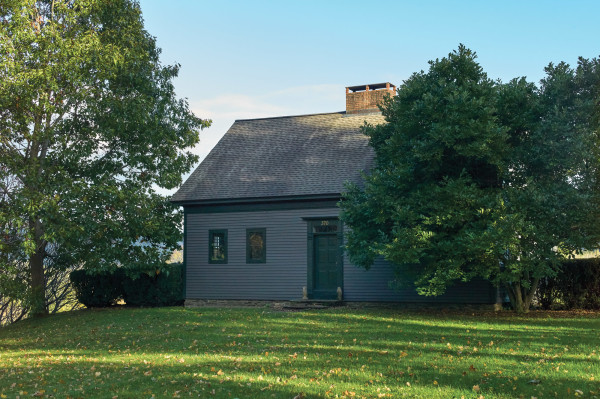
The house is set on glacial terrain that drops down to a lower area in back. From this view, no one would guess the house has 11 rooms.
Gridley + Graves
When Buzz Hesse saw a horse standing in the open front door, chickens running in and out around its hooves, he knew he had to act. The ca. 1795 house was unpretentious, but as someone with expertise in both antiquities and antiques, Hesse knew it was important.
Actually, the house wasn’t new to him. Many people in the antiques business had coveted it for years, and it was documented in the architectural history Landmarks of Otsego County New York.
Until recently the house had been occupied by tenant farmers. When the farm failed, the owners abandoned it. Hesse’s first bid to buy the house fell through, but he persisted, and a couple of years later it was his.
Hesse’s rescue wasn’t the first narrow escape for the house. In the late 18th century, this was the frontier, and an area that largely had been loyal to the Crown during the Revolution.
That made it ground zero for the border wars of New York, the military campaigns against the Loyalists and Native American tribes that had sided with the British. Most notable was the Sullivan Expedition that destroyed more than 40 Native American villages as well as Loyalist homes and settlements.
In the early 19th century, raids that led to the War of 1812 ravished the area again; once more houses and whole villages burned to the ground.
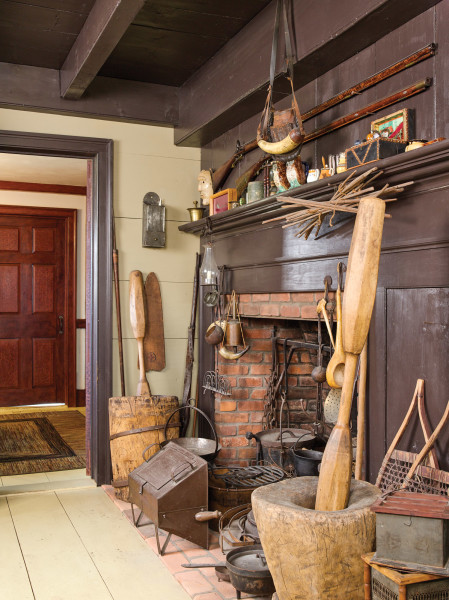
“Food tastes different,” say the owners, who have cooked over the hearth. A love for utilitarian objects led to collecting 18th-century cooking tools and instruments. On the wall next to the fireplace is a rare tin pipe box with a drawer. Beneath that hangs an Iroquois muskrat board used for stretching and drying hides.
Gridley + Graves
In the years after its abandonment, a well-built roof had saved the house. Buzz Hesse knew he’d picked a survivor! Now, however, he would have to remove it from the farm. How? “Very carefully,” Buzz laughs. “We took it apart: pin by pin, board by board, we numbered every piece, and we stored it.”
Along the way, discoveries were made. During the Victorian era, two primary rooms had been lathed and plastered over. During disassembly, the plaster came off and underneath were the original walls and beams, hand planed, in perfect condition. “The walls are just beautiful, unpainted random-width boards with thumbnail beaded edges,” Hesse says. More happy surprises included the original mouldings, chair rails, and hardware, all intact. When Hesse and his wife, Jackie, found some property that would do the old house justice, they began the careful process of reassembly.
Hesse was equally meticulous in his reconstruction, but there was some serendipity, too. Take the large quantity of antique nails he’d discovered at a flea market: “The beauty of it is, I bought them way before I bought the house, so I had all the nails I needed and more.” The parlor walls revealed the ghosting lines of a corner cupboard removed long ago. Hesse happened to own one that fit the outline exactly.
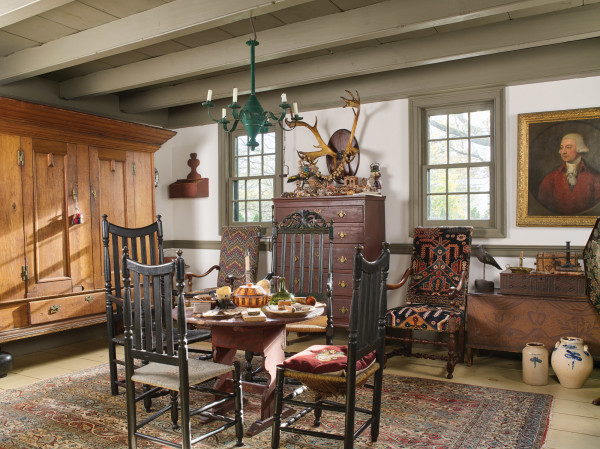
Chairs beside the tall chest are ca. 1680. The black banister-back chairs are American, ca. 1740–60. A Hudson Valley kas has bun feet made of tulip wood. Now visible, the original ceiling was smoothly finished and boards beaded on the edge. The tin chandelier has tole decoration.
Gridley + Graves
Other things weren’t as effortless. Forced by building codes and harsh winters to install modern heating and lighting, Hesse did his best to disguise them. “I hid rectangular ducts in the walls and have little heating vents come out in the mopboards. That way I didn’t have to cut holes in the walls.” He hid electrical outlets behind furniture.
If ever anyone was well equipped to furnish an early house, it’s Buzz and Jackie Hesse. The couple recently retired from 30 years running Hesse Galleries, a nationally recognized antiques auction house in Otego, New York, though Hesse continues to buy and sell antiques. “I bought my first antique in 1955, when I was in high school,” he remembers. “I was smitten by late 17th- and 18th-century furniture and I still am.”
Every piece has a story. Hesse is incredibly knowledgeable about the objects here: their age, provenance, aesthetic value, and so on. Often they carry a delightful dash of local history. Take, for example, the portrait hanging in the foyer. “That’s Almina Northrup. She and her brother Avery lived six or seven miles over the hills in Franklin, a village that runs into the Susquehanna River. The curious thing is the frame. That’s a cutout leather-trimmed wooden frame—leather grapes and leaves are attached to the frame. Almina made that around 1850 or ’60.” He also owns another piece by the talented siblings, a painted cupboard with leatherwork accents.
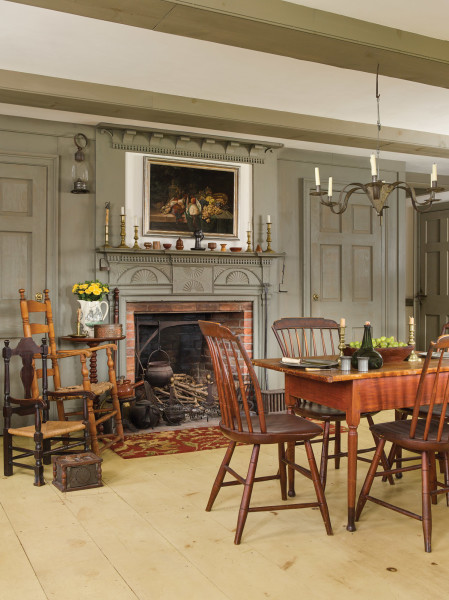
In the Tavern Room, a meticulous addition to the house, the mantelpiece was purchased from a house being razed in Otsego County. Other woodwork is an exact reproduction of what was found here. The paint color was mixed to match the original colors found under a later ceiling.
Gridley + Graves
A corner cupboard in the Tavern Room hailed from Veeder Tavern, an 18th-century hostelry on the Mohawk River. The person who inherited it chose not to sell, but contacted Hesse some years later. During that time, the cupboard had languished in a metal storage unit long enough for the owner to lose the key, and for hornets to build a large nest inside. Undeterred, Hesse broke the lock, braved the hornets, and brought the piece home.
The Tavern Room is the only addition to the old house. Back in the 19th century, the house had gotten a “horrible” Victorian addition, which was left behind and bulldozed into the old cellar hole. Once the house was rebuilt, Hesse planned to put a garage in its place. One day, standing where the Victorian entry door had been, Buzz changed his mind. “It sounds funny, but suddenly I envisioned the whole Tavern Room, right there before me.”
Hesse followed through on his vision with great care. Everything here is architecturally in keeping with the original house. Moulding and chair rails were precisely reproduced. Handmade firebricks were dug out of local ruins, cleaned, and reused here. Those antique nails he had bought years ago came into play. “I was fanatical about it,” Buzz explains. “Keeping it correct was a matter of integrity, not deception; I love the old house.” The room was then furnished with an exquisite collection of antiques collected over the years.
The Hesse house and everything in it survived, things so well-crafted and beloved (or just lucky) that they are still with us. Buzz and Jackie Hesse are their guardians, whose care and protection ensure their survival for the future.
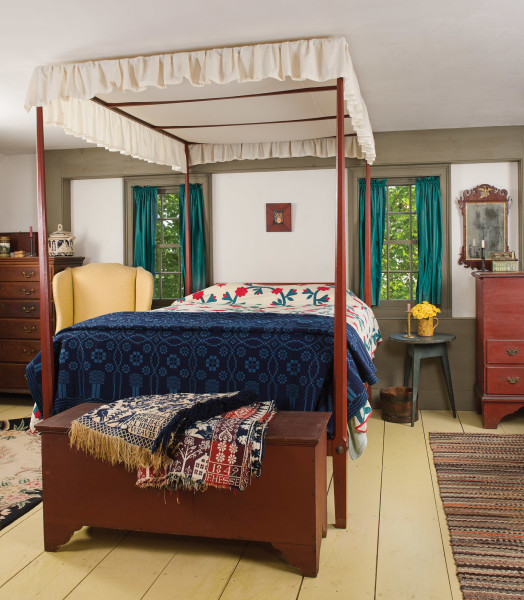
The master bed is perhaps the only reproduction in the entire house. “At six-two, I couldn’t find an antique bed comfortable for me,” Hesse says. The late master carpenter Richard Bury made his an authentic reproduction a bit wider than the original. “There is virtue in the well-crafted object, its precision, even when it is new.”
Gridley + Graves
Hesse Archaeology Museum
Buzz Hesse’s original profession was archaeologist. He worked with the New York State Museum and Science Services and is a contributing author of a two-volume work, The Pre-History of the Upper Susquehanna River Basin. After moving into the antiques and auction fields, he continued the archaeology work independently, even locating and excavating a historic Native American village, Unadilla, that had been burned by Continental troops in the late 18th century.
Hesse’s lifelong passion resulted in a magnificent collection and the opening of his Hesse Museum of Archaeology, which occupies a building on his property. It is filled with artifacts spanning 14,000 years—which he acquired during independent archaeological investigations or in years of collecting with his wife. The Museum ranges widely, from Iroquois False Face Society masks to the possessions and entire background of one Civil War soldier. “Both Jackie and I feel incredibly privileged to have acquired these things,” Hesse says, and they have generously made the Museum free of charge to the public. Visitors to the area are welcome to call ahead for an appointment: (607) 287-5320
See another fine, replica tavern room: oldhouseonline.com/articles/vintage-tavern-room







